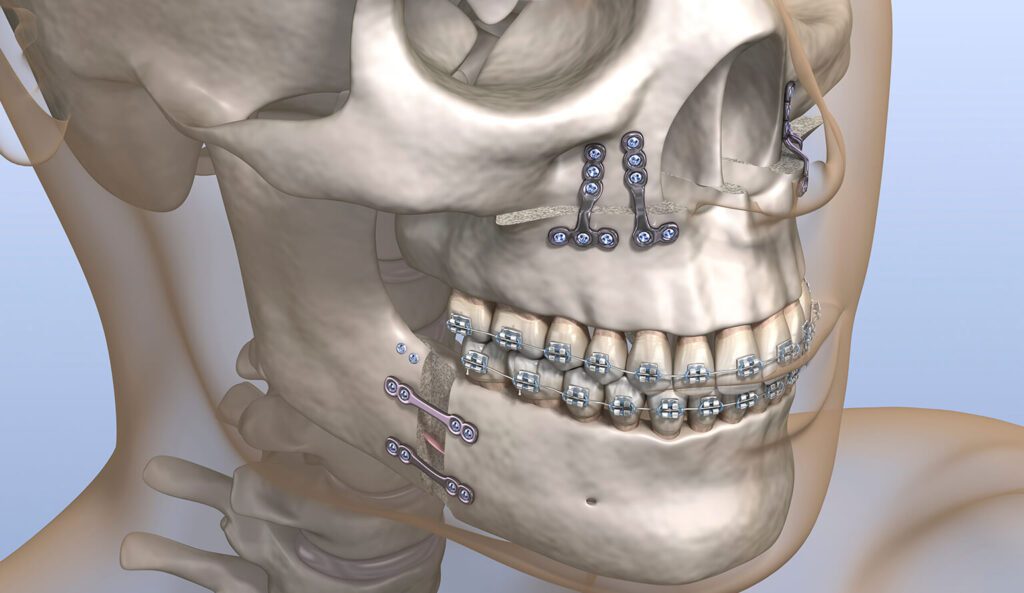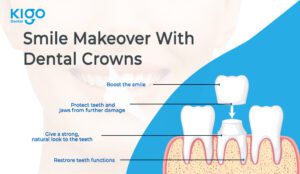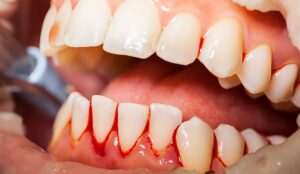Surgical Orthodontics
Uncompromised quality
We use quintessential quality materials and stringent sterilisation protocols to ensure that you don't have any medical or dental complications in future.
Anxiety Free Dentistry
Experience the treatment process in a pleasant atmosphere from handpicked expert clinicians, with unparalleled clinical etiquette, to ensure exemplary health care.
Best in class outcomes
We strive our best, so that we can keep our promise of delivering the individualized smiles that we have reimagined for you with latest techniques and technologies.
Jaw correction with Orthognathic Surgery


Sometimes, a patient’s dental and skeletal problems go beyond the scope of treatment by orthodontics alone. Orthognathic surgery in conjunction with orthodontic teeth movement may be necessary to correct the bite when misalignment of the jaw is the underlying cause due to abnormal skeletal development.
Orthognathic surgery, more often known as jaw surgery, realigns the jaws to improve looks and restore balance of the face & skull.
A combined treatment from both orthodontist and oral & maxillofacial surgeon may be needed when tooth and jaw misalignment (malocclusion) cannot be fixed by braces alone. If you’re unhappy with the gap between your upper and lower jaws, this procedure can help you achieve a more pleasing appearance by repositioning your jaws. Assuming that jaws will be brought into alignment, an orthodontist can reposition the teeth into their right positions.
Prior to, during, or after having braces removed, you may be treated by a jaw surgeon to address the issues that need to be corrected. Your orthodontist and surgeon will go over the pros and cons of both surgical and nonsurgical treatment options with you so that you can make an informed decision.
Correcting severe skeletal irregularities including retruded or projecting jaws, an open bite, or a crossbite can be accomplished with this procedure. Surgery of the jaw can realign the bite and enhance facial aesthetics by lengthening or shortening the jaw, or by moving the jaw forward, backward, or even up and down.
Although most jaw surgeries are done for corrective and functional purposes, a surgeon with knowledge in facial aesthetics is crucial because jaw adjustments have such a profound effect on one’s appearance.
Orthognathic surgery is performed to address significant deformities of the maxilla (upper jaw), mandible (lower jaw), or both jaws. The deformity may have been present at birth, developmental problems, or resulted from damage to the jaw. In growing years, the choice of treatment is growth modulation treatment, which is a nonsurgical treatment. In nongrowing adults orthognathic surgery along with orthodontics is the choice of treatment.
Orthognathic surgery may be necessary in cases of malocclusion (a misalignment of the teeth) with severe discrepancies.
When a person with this malocclusion bites down, their lower front teeth align vertically behind their upper front teeth. Compared with Class II and Class III malocclusions, this is thought to be less severe. Although this is a close to normal occlusion, the skeletal deep bite and open bite associated with class I malocclusion may warrant for corrective jaw surgery.
An indication of this is when the lower front teeth bite significantly far behind the upper front teeth, sometimes making contact with the soft tissue behind the uppers. This condition is known as an class II malocclusion with increased overbite, and it can lead to pain, bone loss, premature wear on the front teeth, and even tooth loss.
When the lower front teeth and lower jaw are placed in front of the upper front teeth, the upper jaw appears significantly smaller in comparison.
- Underdeveloped lower jaw with normal upper jaw.
- Underdeveloped upper jaw with normal lower jaw.
- Underdeveloped upper and lower jaws.
- Overdeveloped lower jaw with normal upper jaw.
- Overdeveloped upper jaw with normal lower jaw.
- Overdeveloped upper jaw with Underdeveloped lower jaw.
- Overdeveloped lower jaw with underdeveloped upper jaw.
- Overdeveloped upper and lower jaws.
Sometimes people’s upper and lower jaws develop at different rates. Disproportions in jaw structure can also be caused by trauma or congenital conditions. When only the teeth are crooked, orthodontic treatment typically does the trick, but when both jaws are out of place, corrective jaw surgery may be required. You may be a suitable candidate for corrective jaw surgery if you have any of the following issues:
- Protruding jaws
- Severe skeletal open bite
- Birth defects or facial injuries
- Receding chin due to small lower jaw
- Excessive tooth wear due to skeletal deep bite
- Unbalanced facial appearance from the front or side
- Difficulty swallowing, biting, or chewing due to smaller lower jaw
- Headache and persistent jaw or jaw joint (TMJ) pain in severe cases
- Sleep disorders due to airway constriction caused by smaller lower jaw
- Inability to make the lips meet without straining due to skeletal problems
The advantages of corrective jaw surgery include:
- Enhancing one’s sense of self-worth
- Facilitated jaw movement (how your jaw works)
- Increased ease of breathing, talking, and eating
- Resolving issues with the teeth and jaw by using a variety of orthodontic equipment (braces, retainers, and even Invisalign)
Beginning with orthodontic treatment to realign your teeth using fixed appliances, the entire process of treatment can take anywhere from two and a half to three and a half years (train track braces).
You will be prepared for jaw surgery when you have completed around two-thirds of your treatment.
Typically, patients continue their orthodontic therapy with fixed appliances for another 6-9 months after surgery.
There will be removable retainers given to you to assist keep your teeth in their new positions once the fixed appliances have been removed. A fixed retainer may also be necessary for some patients.
Your orthodontist will give you specific instructions on how often you should wear the retainers. For the first year, most people are instructed to wear retainers full time, but after that they should wear them during night time.
Wearing retainers is an important part of the treatment success as it helps in preventing relapse of the treatment back to its initial problematic stage.
From the time of your surgery until the end of the few years as decided by doctor, you will undergo frequent checks to assess your recovery.
Preparation for jaw surgery might take a long time. When planning surgery, your doctor will require specific details from you. Some of the many tests and investigations they could use to obtain it are listed below
- X-rays.
- CT scans, or computed tomography scans.
- Teeth and jaw scans or photographs.
- Make a dental cast from your impressions.
- A dental scan could also be performed.
It’s possible that you’ll need work done on either your upper or lower jaws, or even a mix of the both, during your surgery.
Since the procedure is performed internally, no external scars will occur.
- For correcting your bite and jaws through orthognathic jaw surgery. The maxillary or mandibular or both maxillary and mandibular osteotomy procedures including cutting the bone above the teeth to free up the jaws and repositioning the jaws and teeth forward or backward until they meet in ideal position is performed. Mandibular osteotomy (surgical on the lower jaw) entails making a cut behind the molars to free up space for the jaw’s front to shift and straighten. To prevent the bone from shifting, plates and screws are employed.
- Your jaws will be adjusted under the gum using plates and screws during orthognathic jaw surgery. You may need to wear orthodontic elastics while your bite heals and adjusts.
- Jaw surgery can change your facial structure and improve your bite (occlusion). The before and after results of jaw surgery can be dramatic. This is the case after substantial corrective surgery, such as that performed to fix a slight setback of the lower jaw or to reduce the protrusion of the lower jaw.
In spite of the rarity of major consequences, anyone considering jaw surgery should be aware of the risks that exist. Orthognathic surgery’s most common short-term complications include:
- Tingling or numbness that comes and goes; it usually manifests itself on the lips, cheeks, or tongue but can also affect the nose and chin.
- Infection of surgical wounds.
- Adverse anaesthetic reaction.
- Tooth damage.
- Nausea and vomiting.
All of us here at Kigo Dental are committed to providing you with the best dental care available, and we do so with a smile.
Our entire staff, from receptionists to dental hygienists and assistants, is committed to providing you with the best quality dental care possible
From the time you walk through the door and every time you revisit, you will experience this firsthand.
Kigo Dental has a team of experienced and skilled Orthodontists and other specialised dentists who specialise in providing high-quality dental care and treatments, utilising the latest technologies and techniques to ensure the best outcomes for their patients.
FAQ's
Surgical orthodontics is a procedure that combines orthodontic treatment with surgical intervention to correct severe or complex dental and facial irregularities. It involves repositioning the jaws and orthodontic movement of teeth to improve their function, aesthetics, and overall health
Traditional orthodontic treatment involves the use of braces or clear aligners to straighten teeth and correct mild to moderate malocclusions. Surgical orthodontics, on the other hand, involves surgery in addition to orthodontic treatment to correct severe malocclusions that cannot be corrected by orthodontic treatment alone
Surgical orthodontics can be used to correct a wide range of moderate to severe skeletal malocclusions which occurred due to skeletal abnormalities including overbite, underbite, open bite, crossbite, and asymmetry in the jaw structure
The surgical orthodontic procedure involves an orthodontist and an oral surgeon working together to correct the malocclusion. Before the surgery, the orthodontist will prepare the teeth and jaws for the procedure. During the surgery, the oral surgeon will reposition the jaws to correct the malocclusion. After the surgery again the orthodontist will finish the settling of the teeth.
There is as such no recovery time needed for surgical orthodontics, but for orthognathic surgery which is performed in between the recovery time can vary depending on the extent of the surgery and the individual patient. However, most patients can expect to take several weeks off from work or school and will need to follow a special diet during the early stages of recovery.
As with any surgical procedure, there are risks associated with orthognathic surgery, which is an adjunct procedure of surgical orthodontics, such as infection, bleeding, and nerve damage. However, these risks are generally low and can be minimized by choosing an experienced and qualified oral surgeon.
Patients with severe malocclusion, facial asymmetry, or jaw deformities that cannot be corrected through orthodontic treatment alone may benefit from surgical orthodontics. This treatment is typically recommended for adult patients, as the jawbones are fully developed by this time.
The process typically involves several steps. First, the patient undergoes a comprehensive evaluation, including X-rays, photographs, and dental impressions. This information is used to create a treatment plan that outlines the specific surgical and orthodontic steps needed to achieve the desired outcome. Next, the patient undergoes orthodontic treatment to prepare the teeth for surgery. The surgery is then performed, and the patient continues with orthodontic treatment to fine-tune the position of the teeth and jaws.
The specifics of the surgery depend on the individual patient’s needs, but generally, involve making incisions in the gums to access the jawbones, repositioning the bones to the desired location, and stabilizing them with plates, screws, or wires. The surgery is performed under general anaesthesia and typically takes several hours.
Recovery time varies depending on the extent of the surgery and the patient’s healing process. Patients can expect some swelling and discomfort and may need to follow a soft or liquid diet for a while. Pain medication and antibiotics may be prescribed to help manage pain and prevent infection. Patients should also avoid strenuous activity and follow any post-operative instructions provided by their surgeon and orthodontist.
The length of treatment varies depending on the individual patient’s needs but typically takes 2 to 4 years from start to finish. The orthodontic treatment phase may take 2 to 4 years, with the surgical and recovery phase embedded in between.
Blogs






Wisdom Teeth: Understanding the What, Why, and When
Wisdom teeth, also known as third molars, are often a source of concern for many people. They can lead to various dental issues, including wisdom






Smile Makeover with Dental Crowns: Types, Overview & cost
A smile is one of the most attractive features a person can have. It can boost your confidence, make you more approachable, and even improve






Beyond the smile: Exploring the crucial role of teeth in your overall health
Teeth are often linked to the ability to smile, eat, and express oneself. However, teeth serve many other vital purposes as well. Your teeth have






The Silent Threat: How Gum Diseases Lead to Tooth Loss
Having strong teeth and gums is a reflection of your entire well-being, not simply your appearance. Despite this, many people don’t give their gums the






The Importance of Orthodontists in Clear Aligner Treatment: Avoiding Problems and Ensuring Successful Outcomes
More and more individuals are seeking out clear aligner treatment as a way to improve their smile in a way that is both subtle and






Understanding Abnormal Dental Habits in Children and the Importance of Control
As parents and caregivers, we play a pivotal role in shaping our children’s habits and behaviors, especially when it comes to their oral health. However,






Wisdom Teeth: Understanding the What, Why, and When
Wisdom teeth, also known as third molars, are often a source of concern for many people. They can lead to various dental issues, including wisdom






Smile Makeover with Dental Crowns: Types, Overview & cost
A smile is one of the most attractive features a person can have. It can boost your confidence, make you more approachable, and even improve






Beyond the smile: Exploring the crucial role of teeth in your overall health
Teeth are often linked to the ability to smile, eat, and express oneself. However, teeth serve many other vital purposes as well. Your teeth have






The Silent Threat: How Gum Diseases Lead to Tooth Loss
Having strong teeth and gums is a reflection of your entire well-being, not simply your appearance. Despite this, many people don’t give their gums the






The Importance of Orthodontists in Clear Aligner Treatment: Avoiding Problems and Ensuring Successful Outcomes
More and more individuals are seeking out clear aligner treatment as a way to improve their smile in a way that is both subtle and






Understanding Abnormal Dental Habits in Children and the Importance of Control
As parents and caregivers, we play a pivotal role in shaping our children’s habits and behaviors, especially when it comes to their oral health. However,






Wisdom Teeth: Understanding the What, Why, and When
Wisdom teeth, also known as third molars, are often a source of concern for many people. They can lead to various dental issues, including wisdom






Smile Makeover with Dental Crowns: Types, Overview & cost
A smile is one of the most attractive features a person can have. It can boost your confidence, make you more approachable, and even improve






Beyond the smile: Exploring the crucial role of teeth in your overall health
Teeth are often linked to the ability to smile, eat, and express oneself. However, teeth serve many other vital purposes as well. Your teeth have






The Silent Threat: How Gum Diseases Lead to Tooth Loss
Having strong teeth and gums is a reflection of your entire well-being, not simply your appearance. Despite this, many people don’t give their gums the






The Importance of Orthodontists in Clear Aligner Treatment: Avoiding Problems and Ensuring Successful Outcomes
More and more individuals are seeking out clear aligner treatment as a way to improve their smile in a way that is both subtle and






Understanding Abnormal Dental Habits in Children and the Importance of Control
As parents and caregivers, we play a pivotal role in shaping our children’s habits and behaviors, especially when it comes to their oral health. However,






Wisdom Teeth: Understanding the What, Why, and When
Wisdom teeth, also known as third molars, are often a source of concern for many people. They can lead to various dental issues, including wisdom






Smile Makeover with Dental Crowns: Types, Overview & cost
A smile is one of the most attractive features a person can have. It can boost your confidence, make you more approachable, and even improve






Beyond the smile: Exploring the crucial role of teeth in your overall health
Teeth are often linked to the ability to smile, eat, and express oneself. However, teeth serve many other vital purposes as well. Your teeth have






The Silent Threat: How Gum Diseases Lead to Tooth Loss
Having strong teeth and gums is a reflection of your entire well-being, not simply your appearance. Despite this, many people don’t give their gums the






The Importance of Orthodontists in Clear Aligner Treatment: Avoiding Problems and Ensuring Successful Outcomes
More and more individuals are seeking out clear aligner treatment as a way to improve their smile in a way that is both subtle and






Understanding Abnormal Dental Habits in Children and the Importance of Control
As parents and caregivers, we play a pivotal role in shaping our children’s habits and behaviors, especially when it comes to their oral health. However,






Wisdom Teeth: Understanding the What, Why, and When
Wisdom teeth, also known as third molars, are often a source of concern for many people. They can lead to various dental issues, including wisdom






Smile Makeover with Dental Crowns: Types, Overview & cost
A smile is one of the most attractive features a person can have. It can boost your confidence, make you more approachable, and even improve






Beyond the smile: Exploring the crucial role of teeth in your overall health
Teeth are often linked to the ability to smile, eat, and express oneself. However, teeth serve many other vital purposes as well. Your teeth have






The Silent Threat: How Gum Diseases Lead to Tooth Loss
Having strong teeth and gums is a reflection of your entire well-being, not simply your appearance. Despite this, many people don’t give their gums the






The Importance of Orthodontists in Clear Aligner Treatment: Avoiding Problems and Ensuring Successful Outcomes
More and more individuals are seeking out clear aligner treatment as a way to improve their smile in a way that is both subtle and






Understanding Abnormal Dental Habits in Children and the Importance of Control
As parents and caregivers, we play a pivotal role in shaping our children’s habits and behaviors, especially when it comes to their oral health. However,
LET'S TALK
Book your Appointment
Appointment Timings: Mon-sat: 10:00 am- 8:00 pm |
Sun: 10:00 am - 1:00 pm
Contact
We would love to be a part of your Smile Reimagining Journey...
- 2nd Floor, QUBE, Plot No: 3-64/A, Kavuri Hills Rd, Jubilee Hills, Hyderabad, Telangana 500033
-
+91 9998884398
- kigodental@gmail.com
-
Mon - Sat: 10:00 am - 8:30 pm
Sun: 10:00 am - 1:00 pm